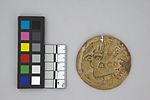Plaque
About this object
History of use
Discs like this have not been published but Sr. Walter Alva of the Bruning Museum in Lambayeque says this type of ornament is associated with Vicus graves. The precise use is not known although the hole suggests they were suspended. Several Vicus effigy ceramics portray a disc hung around the neck of the figure.
Narrative
Vicus style ? Early Intermediate Period; 300 B.C.E. - 600 C.E.?
Specific techniques
This disc has a relatively thick and continuous layer of yellow-coloured metal over the surface of one side, including the incisions. The incisions are trapezoidal in cross-section and made up of a series of short, straight lines. ESM analysis (Sf597) showed surface is half gold, half copper while the interior is mostly copper with some gold and a trace of silver. Of the gilding techniques known for the Vicus area, electrochemical replacement plating is most consistent with these features.
Physical description
A thick gilded metal disc which has an incised design of a bird in profile. It has a semi-circular eye with vertical plumes on its head. There are also three small squares on the side of the bird. The design fits inside a circular incised border. There is a small, hole above the head plumes near the incised border. The back of the disc is undecorated.
Categories
Materials
